Promotion of Multiregional and Multilingual Websites

When companies aim to enter international markets, they often face the question: «How should we properly create a multiregional and/or multilingual website to reach a wider audience?»
For Google, it’s not enough to simply translate site content into the necessary languages. Site functionality, meta tags, and adherence to essential technical parameters are also crucial, as is following search engine recommendations.
In this article, you’ll learn the differences between multiregional and multilingual sites, how to help search engines determine a site’s regional affiliation, what a multilingual site should include, and the strategies available for multiregional promotion.
But first, let’s address the primary debate among experts: should a multiregional and multilingual site be built using folders, subdomains, or regional domains?
The best option is to create separate internal categories and folders, but there may be exceptions. Any niche requires an analysis of the region you want to target. Each implementation method has its own drawbacks. Read more about the methods and their pros and cons below.
- What is a Multilingual Site?
- What is a Multi-Regional Site?
- How to Help Search Engines Determine a Site’s Regional Affiliation
- What Should Be on a Multilingual Website
- Strategies for Multi-Regional Promotion
- Search Promotion in the Primary Region and Online Advertising in Other Regions
- Promotion Using a List of Region Names in Content
- Promotion Only for Geo-Independent Queries
- Creating Regional Landing Pages
- Creating Subfolders for Regions
- Cloning the Main Site for Each Region
- Completely Separate Websites for Each Region
- System of Regional Domains
- Forum Links as an Effective Method of Promoting Multilingual and Multi-Regional Sites
- Briefly About the Main Points
What is a Multilingual Site?
A multilingual site is a resource that contains adapted content in two or more languages. Typically, these sites are aimed at visitors from multiple countries or cater to various language speakers within the same country. For example, a website based in the United States might have content adapted for both American English and Spanish.
It’s recommended to adjust the site’s display so that the language adapts based on browser settings and users’ individual preferences, independent of geographical location.
The advantage of multilingual sites is their ability to present content in users’ native languages, enhancing user experience. However, this does not address functional issues, such as displaying relevant currencies or units of measurement.
What is a Multi-Regional Site?
A multi-regional site is a resource designed to cater to visitors from various countries. Such sites can be both multi-regional and multilingual simultaneously.
A multi-regional resource is structured so that users see content relevant to their location. For example, residents of different countries will view the prices of goods and services in their local currency, as well as important regional information, such as area-specific contact details.
However, a multi-regional site, while advantageous in its ability to adapt to regional specifics, has a key drawback: a visitor traveling to another country may not necessarily speak the local language.
For instance, if an American travels to Italy and visits a global online store, the content would appear in Italian. However, if the site is both multi-regional and multilingual, the visitor can easily switch to a language they are comfortable with.
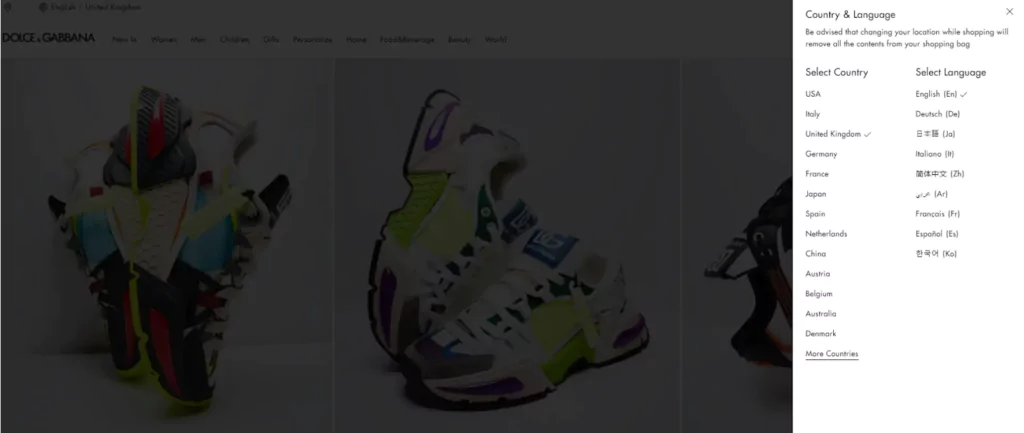
How to Help Search Engines Determine a Site’s Regional Affiliation
The difference between multi-regional and multilingual sites has been clarified. But how can a search engine determine which specific region a resource belongs to when generating results? This is where the hreflang attribute comes in.
In addition to this attribute, Google also considers the contact details provided on the site, such as phone numbers, emails, and physical addresses.

For accurate ranking, check and set the target country in Google Search Console. Additionally, be sure to add information in Google My Business.
What Should Be on a Multilingual Website
As we’ve mentioned, simply translating content into the required language isn’t enough when creating a multilingual site. Several technical parameters must be followed. Let’s go through each of them.
The hreflang Attribute
The first important step is assigning the hreflang attribute. This attribute specifies the language in ISO 639-1 format and, if necessary, the region in ISO 3166-1 Alpha-2 format for the alternate URL.
It’s not required for the language to be directly tied to the region.
For example:
- en – content in English for any region;
- en-GB – content in English for users from Great Britain;
- de-ES – content in German for users from Spain.
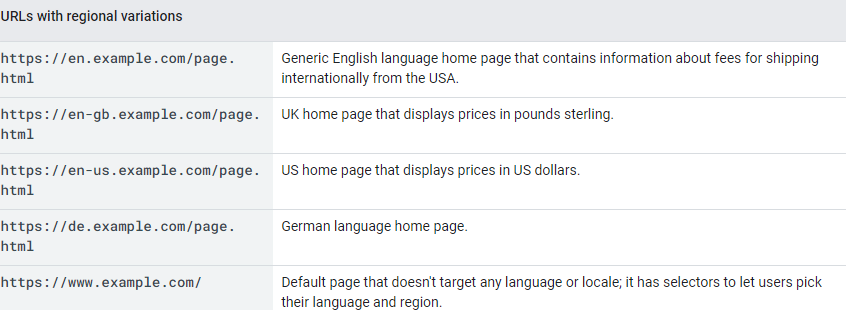
You can learn how to correctly set the hreflang attribute from Google Help.
Sitemap File
You can inform Google about the variants of site pages in alternative language versions using the Sitemap.xml file (site map). To do this, add the <loc> element to the map with the URL of the pages, and in the <xhtml:link>, provide links to their versions in different languages and regions, including the original URL.
For instance, if you have four page variants, the sitemap will include four elements, each with four child tags.
Here is an example of how to add page versions to a Sitemap file from Google Help:
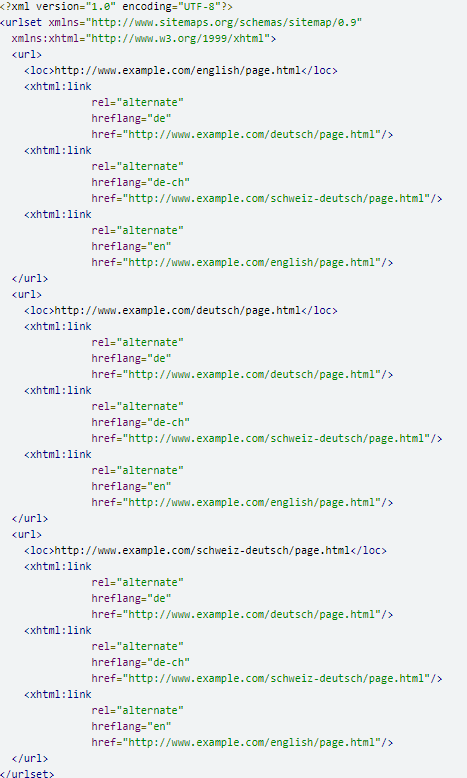
Meta tag
It is crucial to translate the title tag and the description meta tag for each page when setting up a multilingual site. This significantly impacts the resource’s ranking in search results.

Don’t forget to translate the alt and title attributes for the images on the site.
Language Switching
The most important element on a multilingual site is the language switching functionality. It shouldn’t just exist; it should be prominently displayed. I recommend placing it in the right or left area of the site header and footer.
Additionally, you can place flags next to the languages/countries. This will make it clearer and speed up the process of finding the desired language.
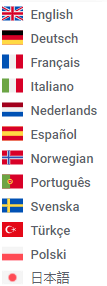
Relinking
Every page on your site should include a link to that page in different languages. This will significantly enhance the usability of the resource.
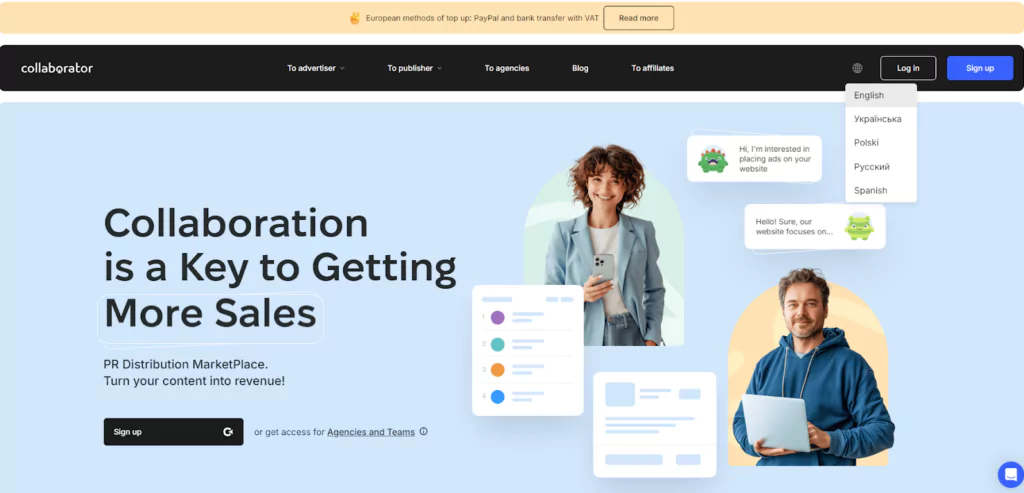
Accordingly, when a user clicks on the desired translation, they should not be redirected away from the page; only the language of the content should change.
For a multi-regional site, in addition to the parameters listed above, the site’s functionality must also be adapted: appropriate currencies, units of measurement, text on images, and interactive content (such as tests, games, calculators, etc.) should all update accordingly.
Assigning Multiple Domain Regions through Google My Business
This is a fairly simple and safe promotion method, especially for those who already have a company profile on this service. Simply enter the necessary addresses, fill in the profile with information, and click «save».
Strategies for Multi-Regional Promotion
After creating and optimizing a multi-regional site, you can begin its promotion on Google. However, there are nuances to consider, which we’ll discuss below.
First, identify the queries you want to rank for, as the search results may be shaped by:
- language only;
- country + language;
- country + language + locality.
By conducting a niche analysis for relevant queries, you’ll gain insights into the specifics for each case.
Search Promotion in the Primary Region and Online Advertising in Other Regions
This approach involves launching comprehensive site promotion with backlinks in the region where the company’s office is located. This strategy helps improve the site’s search ranking for the primary location as well as for additional regions in other languages.
In addition to comprehensive promotion, contextual advertising is often launched, which can be targeted to both the main region and neighboring countries.
The advantage of this method is that it doesn’t require extensive or region-specific adjustments to the site or additional addresses in neighboring countries.
The drawback is that visitors may be less inclined to trust sites displaying contextual ads from foreign regions.
Promotion Using a List of Region Names in Content
The idea here is to specify target regions in the text, for example, in headings (H1-H6) as well as in the main content of the page.
This is the simplest and most accessible method for promoting a multi-regional site and does not require functional modifications. However, it’s worth considering carefully before choosing this approach, as site geotargeting in Google Search Console is done at the domain level (e.g., site.ua) or by folder (e.g., site.com/en/).
This method requires listing all the locations you serve on the current pages, but there’s a risk of being penalized for keyword spamming.
It is only effective for non-competitive niches.
Promotion Only for Geo-Independent Queries
This method is often used to promote a site for informational and non-commercial queries. Therefore, the content strategy should be structured based on methods for monetizing an informational site. However, in certain niches, geo-independent queries can also be commercial.
Creating Regional Landing Pages
This approach is more complex from a site administration perspective compared to standalone pages. If you create separate pages for specific regions, you must ensure that the correct contact details, currency, and content are displayed on each of these pages.
The result is a more complex site structure for both visitors and search engines, which can be challenging to implement on certain CMS platforms.
Additionally, with this promotion method, it’s essential to include toponyms (names of locations) in meta tags and H1-H6 headings to improve search ranking outcomes.
Creating Subfolders for Regions
This is one of the most effective options for promoting a multi-regional site. To implement it, simply install a multilingual module on your site, which is available on most popular CMS platforms.
Next, categories and subfolders are created to copy and translate the relevant content. This method preserves the site’s link authority, as the promotion strategy is implemented within a single domain.
Since this option is highly effective, it is even supported by some website builders, which allow you to copy and translate individual pages.
Cloning the Main Site for Each Region
This approach involves creating a separate site for each region at minimal cost by cloning the main resource. After cloning, the content is adjusted, and the contact data is updated to reflect the respective regions.
The cloning process is fairly quick and requires no specialized management system or technical improvements.
However, the downside of this option is that each site must be managed individually. If content updates are needed, changes will have to be made manually on each cloned site separately.
Completely Separate Websites for Each Region
This option involves creating independent websites in terms of functionality, content, and design for each region, taking into account all the peculiarities and nuances of promotion.
The advantage of creating separate websites is that they are more effectively promoted through links, as they are fully optimized and tailored to a specific region (similar to the promotion of independent resources).
The disadvantage is that it is quite expensive and difficult to implement. In addition to creating the websites themselves, it is necessary to hire a separate team for each region. If the website templates differ from one another, the link equity may not be transferred using the hreflang tag. The search engine may not recognize that the site is a regional representation.
System of Regional Domains
A very convenient and user-friendly method. The system of regional domains independently replaces contact data and content on the resource depending on the region from which the user accesses it. This effectively simulates the creation of individual websites for each region.
The main and, perhaps, decisive challenge for many companies is the technical implementation of this functionality. Not every management system allows for modifications to the software code to add tools for creating regional domains.
You also need to analyze your niche and understand how your competitors rank. The link equity will be fragmented, as it will point to different subdomains.
Forum Links as an Effective Method of Promoting Multilingual and Multi-Regional Sites
For link promotion of multilingual and multi-regional sites, forum links are the easiest and most flexible method for obtaining initial links. They allow you to work with all desired regions simultaneously, provided that a well-thought-out link-building strategy is chosen. You can implement this yourself or outsource it.
Why is it profitable to outsource?
When transferring a link building campaign, you avoid:
- Independently developing a strategy for each region;
- Selecting relevant discussions for each region (especially challenging in the middle of the promotion when the main quality donors have been utilized);
- Creating and promoting author profiles;
- Selecting performers—native speakers;
- Establishing KPIs for performers;
- Regularly monitoring the process and dealing with moderation (deletion) of posted content;
- Conducting independent analytics to track campaign effectiveness.
Advantages of transferring forum links for multi-regional and multilingual sites to Brandcitations:
- comfortable personal dashboards;
- a variety of payment methods;
- a personal manager who is always available;
- the ability to monitor the process and approve platforms and posts;
- a one-month guarantee on links;
- we write posts in English, Polish, Spanish, German, Italian, and French;
- we operate in over 10 countries worldwide;
- all work is conducted manually (no special software);
- each post undergoes strict moderation on our part;
- you can earn 10% from each referred client throughout the entire duration of their cooperation with Brandcitations under the Affiliate program.
Do you want to order forum links for your multi-regional or multilingual site from Brandcitations? I recommend setting up language versions in personal dashboards as separate projects for each region. This way, the process will be easier and more efficient.
To see the effectiveness of the link-building strategies employed by the Brandcitations team, check out the case studies of our clients’ website promotions and their feedback on our collaboration.
Briefly About the Main Points
Multilingualism is the primary condition for promoting a site in different regions. It can be implemented using various options: on different domains, subdomains, separate folders and categories, with the help of special modules, or by creating individual sites—everything depends on the budget, capabilities, and human resources.
The key technical points to consider are
- Be sure to set the hreflang attribute;
- Implement appropriate markup in the Sitemap;
- Accurately translate the site content;
- Write/translate meta tags;
- Implement a convenient language/region switch;
- Interlink pages/sites.
The optimal way to create and promote a multi-regional and multilingual site is by establishing subfolders and categories on the main site. This approach ensures that all link equity is transferred to the target resource, rather than being diluted across clones and individual regional domains. However, consider your specific situation within the niche.
The most effective and straightforward method for acquiring links for such resources at the initial stage is to outsource forum links. This strategy allows you to promote across all regions simultaneously without compromising quality or incurring significant financial costs.
You can also enhance the link-building strategy for such sites by adding:
- Local directories links. These links effectively diversify the link profile with natural backlinks, demonstrate the site’s geographic relevance to Google, and ensure dynamic growth of the link equity;
- Guest articles. This method is more complex but absolutely effective for promoting a site to the top of Google. High-quality guest articles can not only develop the site’s link profile but also establish your expertise and increase trust in the brand among the target audience;
- Link Insertion (Niche Edits). These are exclusive links from top-performing pages that already have weight, traffic, and rankings in Google for relevant queries, providing faster promotion. You can inquire about them in the chat on the website.
Order backlink building service from a reliable link building provider Brandcitations. Brandcitations is the best place to buy backlinks for SEO.
Read Brandcitations link building case studies and Brandcitations company reviews to get rid of your doubts about buying link building packages.




